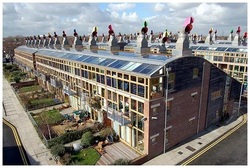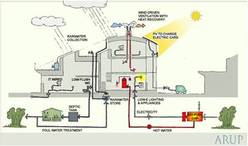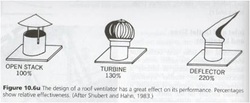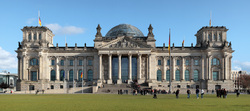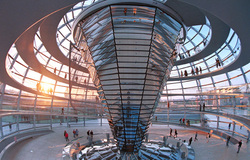MILD CLIMATE
Mild climates are those without extremes of temperature and precipitation (rain and snow). The changes between summer and winter are generally invigorating without being very extreme.
ENGLAND:
The BedZed community in London is a collection of esoteric looking buildings designed from the ground up for carbon neutral living. Built by the Peabody Trust, a charitable housing trust and registered housing association, Bedzed relies on simple, pragmatic design decisions to keep carbon footprints to a minimum. In addition to the usual green staples of solar roofs and combined heat and power boilers, meters showing energy use are shown prominently in the house rather than being hidden out ofsight.
Other low tech but surprisingly effective steps include extra thick walls to keep heat in, well placed windows to make the most of the sun’s energy to heat and light the house, and some clever thinking about how air moves in them to keep the houses pleasant to live in; no need for fans or air conditioning units. By funnelling all the air in the house through a single point, hot air leaving the house warms cool air entering coming in, so no energy is wasted on heating or cooling. Architect Bill Dunster, whose practice designed the BedZed project, says that low carbon living done right ends up as a double win. ‘You will not only start saving money within a year, but you’ll also be saving the planet -which can’t be bad, can it?’
The BedZed community in London is a collection of esoteric looking buildings designed from the ground up for carbon neutral living. Built by the Peabody Trust, a charitable housing trust and registered housing association, Bedzed relies on simple, pragmatic design decisions to keep carbon footprints to a minimum. In addition to the usual green staples of solar roofs and combined heat and power boilers, meters showing energy use are shown prominently in the house rather than being hidden out ofsight.
Other low tech but surprisingly effective steps include extra thick walls to keep heat in, well placed windows to make the most of the sun’s energy to heat and light the house, and some clever thinking about how air moves in them to keep the houses pleasant to live in; no need for fans or air conditioning units. By funnelling all the air in the house through a single point, hot air leaving the house warms cool air entering coming in, so no energy is wasted on heating or cooling. Architect Bill Dunster, whose practice designed the BedZed project, says that low carbon living done right ends up as a double win. ‘You will not only start saving money within a year, but you’ll also be saving the planet -which can’t be bad, can it?’
For more information about BedZed click HERE.
GERMANY:
Lord Norman Foster's new Reichstag in Berlin combines unlike structural elements: portions of the original parliament building (transported from Bonn), a steel-reinforced glass dome 40 meters in diameter, and several innovations in eco-architecture.Thebuilding’s re-imagined dome is the central element in which all of these issues meld. It serves as a high-tech example of the stack effect seen in passive ventilation. The glazed dome is an architectural nod to the dome that was damaged during WWII, and it also serves as complex light funnel, bringing daylight deep into the building.
NATURAL VENTILATION: Within the steel and glass dome, is an inverted conical structure, which performs dually in the passive ventilation of the Reichstag, and in a day-lighting capacity as well. The inverted cone, referred to as the ‘light sculptor’ is covered in reflective surfaces that bounce light from the horizon (as opposed to direct sunlight) into the assembly chambers. The light sculptor is effectively acting as a lighthouse in reverse. In order to reduce glare and heat gain from the light sculptor’s reflective surfaces, a rotating sun shade along the inside edge of the dome is operated by computer and follows the sun’s course through the day. The light sculptor also funnels heat gain at its apex. The hot air within this cavity rises and is exhausted at openings at the top of the dome. This displaced air draws fresh air from intakes located at the perimeter of the building.
OTHER ECOLOGICAL FEATURES:
For more information about Reichstag click HERE.
Lord Norman Foster's new Reichstag in Berlin combines unlike structural elements: portions of the original parliament building (transported from Bonn), a steel-reinforced glass dome 40 meters in diameter, and several innovations in eco-architecture.Thebuilding’s re-imagined dome is the central element in which all of these issues meld. It serves as a high-tech example of the stack effect seen in passive ventilation. The glazed dome is an architectural nod to the dome that was damaged during WWII, and it also serves as complex light funnel, bringing daylight deep into the building.
NATURAL VENTILATION: Within the steel and glass dome, is an inverted conical structure, which performs dually in the passive ventilation of the Reichstag, and in a day-lighting capacity as well. The inverted cone, referred to as the ‘light sculptor’ is covered in reflective surfaces that bounce light from the horizon (as opposed to direct sunlight) into the assembly chambers. The light sculptor is effectively acting as a lighthouse in reverse. In order to reduce glare and heat gain from the light sculptor’s reflective surfaces, a rotating sun shade along the inside edge of the dome is operated by computer and follows the sun’s course through the day. The light sculptor also funnels heat gain at its apex. The hot air within this cavity rises and is exhausted at openings at the top of the dome. This displaced air draws fresh air from intakes located at the perimeter of the building.
OTHER ECOLOGICAL FEATURES:
- Heat exchangers recover and re-utilize warm air not expelled through the dome.
- Intelligent windows' comprise a manually operated inner layer and security-laminated outer layer which draws in fresh air via ventilation joints
- Renewable vegetable bio-fuel burned in a co-generator produces clean electricity, reducing annual carbon dioxide output by 94 percent.
- Surplus heat stored in natural aquifer provides hot water for heating.
- Cold water is stored below ground to provide cooling via chilled ceilings in hot weather.
- Photovoltaic cells cover 300 square meters on the south roof.
For more information about Reichstag click HERE.
